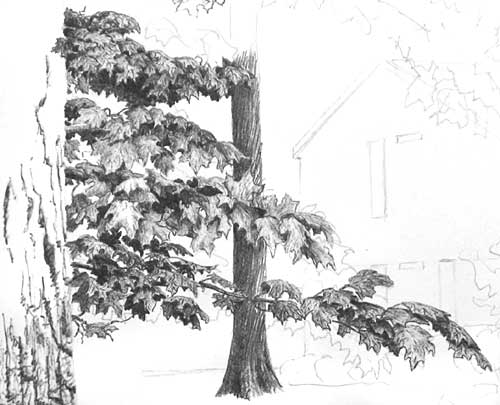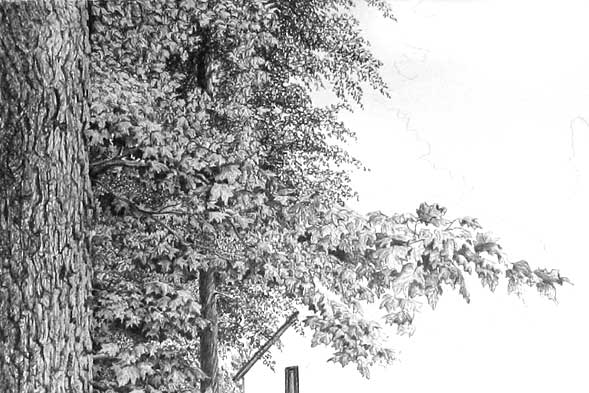
Drawing Trees Tutorial 2 — part 3
by Vincent D Whitehead ©2008Leaf Work - Tree Foliage
The third leaf clump is one that has a lot of underside leaf work showing. It is important that you show this detail in a tree drawing such as this to build height as well as depth in your drawing.

From the viewer's perspective in this image the bottom of some leaves are seen. To draw this I proceed as before with my Fine point pen and do the light edge lines. Then I determine which leaves are actually portions of ones from the opposite side of the leaf clump or ones that are bottom views. I take my Fine point pen and put light layers of ink in to show shadows with the darkest ones being the leaf portions that would be farthest away from the viewer or totally in shadow on the underside of the clump. There are between 3 and 4 layers in the general dark tones with up to 6 or 7 layers in the darkest. I use the very tip of the pen to go back over the bottom of each leaf at the darkest edges to push, as it were, the darkest edges back under the leaf clump. I use a medium pressure for this. Not enough to indent the paper surface deeply but, enough to insure that the ink coverage is consistent and dark.

Indenting
Indenting is a technique used by artist to force a tool into the surface of their "support" (paper or whatever they are working on). This can be done to help create a greater feeling of depth in ones work. It is also used to create a line or area in the drawing surface that will stay at a level of tone that it was at before the indention was done. Then when the artist applies the next layer of medium over that section, the indented area is seen lighter or a different color than the area with the newest layer applied. I have a Fine point pen that I have taken the ink tube out of for just this purpose. I use the smoothness of the ball to indent a line in the surface of the paper to do grass work or weeds when I want the rest of the area to be darker than those lines. Care must be taken when indenting is done. Too much pressure and you can ruin the surface or God forbid, go through it. Once the surface is indented it is very difficult to remove.Completing the section
Since the rest of the tree trunk is not covered by any overlapping limbs or branches it can be finished by using the techniques that we have already gone over. Refer to the reference photo and put in the bark layout lines so that the rest of the tree trunk matches closely and follows the same growth patterns through out. There will be some slightly darker shadows on the left side trunk edge. This shows that the trunk is rounded away from the viewer and it gets naturally a bit darker as it goes up away from the viewer. You must also remember, as we discussed, that the details get smaller and less distinct in the bark work the farther away they are from the viewer.In keeping with this same theme the foliage work as I have said follows the same path. Your leaf work will get smaller and less detailed. Only the indication of edges will be seen and not the crisp, defined lines as in the closer leaf clumps. You can see this in the upper portion of the tree image below. The change should be gradual.

In this image you can also see how the longest of the branches extends into the view of the home. It is important to maintain the direction of the leaf points as they are pulled by gravity out and downward naturally. The shadows show the underside of leaves and the highlights show leaves that are closer to the viewer as the sunlight reflects off the smoother top surface. While turned up leaves show both highlights and shadowed sides and edges. Still others appear almost white on the paper as they catch more light from the sun. Careful consideration to the reference photo is imperative here to get a rendered image that reflects the scene so closely that it is recognized without question by the property owner or anyone who would know the property. This more exact interpretation is not as important when drawing a scene that is fictitious or not to be recognized as being a certain specific location.
I hope that these instructions have been helpful to you in rendering leaf work in your drawings. The following section, "Tutorial 3", will be on Mid-ground and Distant Trees and leaf-work. They all play important roles in producing a believable image and must be given careful consideration. If you have any questions on this section, or the tutorial as a whole, please feel free to and I will be glad to answer you. Your comments are appreciated.